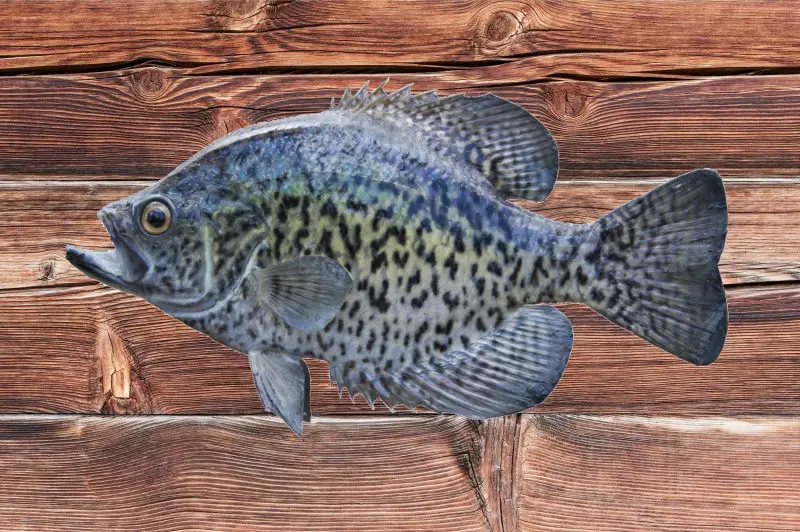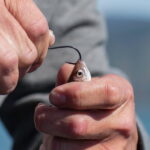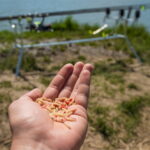You just caught the biggest crappie of your life and are excited to mount it on your wall, but you don’t want to mount a fish that’s too small. Determining if a fish is big enough to mount on your mantelpiece can be challenging—especially if you’re a new angler. Accounting for size ranges for male and female crappies and the minimum mounting sizes requires deep knowledge of the fishing sector.
The right size crappie to mount is between 13 to 15 inches (33.02 to 38.1 cm), weighing between 1 and 2 pounds (0.45 and 0.91 kg). Crappies measuring this size are worth mounting since they are fully grown with sufficient scales for mounting. Male crappies are usually larger than females.
In the rest of this article, I’ll discuss the size of the crappie worth mounting. You’ll also know what size crappie is considered trophy-worthy. Let’s get started!
Note: most links in this article are Amazon.com Affiliate links, see Affiliate Disclosure, thank you.
How Big Should Crappie Be—To Be Worth Mounting?
Fish mounting is a unique way to remember and celebrate the adventure. It helps you reflect on one of the noteworthy fish you caught in your lifetime, the time you spent on the water, and the people with which you shared the experience.
Using taxidermy on crappie fulfills a particular purpose for a unique fish. Since it’s easier to catch small-sized crappies, it’s a prize worth celebrating when you land a big one. The mount-worthy crappie should be a size that requires fishing expertise to land. The crappie should be the size most anglers will agree is a significant catch.
Any crappie exceeding 13 inches (33.02 cm) is worthy of mounting. According to the U.S. Fish & Wildlife Service, the average crappie length is between 10.8 and 19.3 inches (27.43 and 49.02 cm). Therefore, crappies exceeding 13 inches (330.2 cm) are over four years old. Catching such an old fish is not a walk in the park since the fish is more experienced and knows how to dodge most lures used by anglers.
Crappies exceeding 15 inches (38.1 cm) are trophy-worthy mounts. These are rare, as most crappies this size swim in deep waters and can be challenging to access. Crappie exceeding 15 inches (38.1 cm) is not only worthy of mounting but also confers bragging rights in the fishing world.
While a fish size to mount may vary, anglers generally agree that crappie should weigh 1 to 2 pounds (0.45 to 0.91 kg) before being mounted. This figure is a suitable mounting weight since most crappies weigh between 1/4 to 1/2 pounds.
However, size isn’t the only factor when deciding to mount a fish. It may still be worth mounting if you catch smaller crappie with unique markings or if you caught it in an unusual location. Ultimately, it would be best if you based your decision to mount specific crappie on personal preference and the story behind the catch.
Types of Fish Mounts for Crappies
Fish mounts come in two types:
- Skin mounting
- Replica mounting
Skin Mounting
Skin mounting involves removing the fish’s skin, preserving it, and stretching it over a mounting form. This process is a traditional method of fish mounting and gives the most realistic look. However, it also requires more maintenance to preserve the mount over time. You’ll have to keep dusting and maintaining the proper temperature and humidity levels around the mount.
When skin mounting, you start by removing all the internal organs, cleaning the fish, and removing its skin. You must remove these organs because they are prone to decomposition and will be challenging to preserve.
You then preserve the skin with salt or another preservative before stretching over a mounting form replicating the fish’s body shape.
Creating a skin mount requires micro-tip scissors to cut through the tight spaces perfectly. The Fiskars 190500 RazorEdge Micro-Tip Scissor (available on Amazon.com) is an excellent option for this job. The scissor has precisely honed edges that will glide through the crappie’s skin for clean cuts.
Here is a video that demonstrates skin mounting:
Replica Mounting
Replica mounting uses fiberglass or resin casts to create a replica of the caught fish. This method is less invasive, as it doesn’t require removing the fish’s skin.
Replica mounts are also easier to maintain since they don’t need the same temperature and humidity levels as a skin mount.
Once the replica is ready, taxidermists add artificial eyes, gills, and teeth.
This method is your go-to option if you don’t want the hassles of preserving fish skin.
However, some anglers prefer skin mounting for a more realistic look. These anglers want to remain with the fish they caught on a specific occasion.
Ultimately, the decision between these two types of mounts comes down to personal preference and how you want to showcase your catch.
How To Measure Crappie for Mounting
It’s essential to get the correct measurement for your crappie before mounting. However, the measuring process can be challenging since you don’t know whether to get the total length, fork length, or standard length.
For mounting, you need to get the fish’s total length.
It would be best if you also considered girth measurement since mounting may not be possible for a slender fish with little girth. Mounting taxidermists use the total length and girth size to create a natural-looking mount.
Here is the procedure to get the total length of your crappie:
- Lay a tape measure on a flat surface: Extend a tape measure slightly exceeding the crappie’s size, and lay it on a flat surface.
- Position the crappie next to the tape measure: Lay the fish next to the extended tape measure. Avoid laying the fish on the tape measure, as this will obscure the readings.
- Adjust the tape measure: Pull the tape and take the first reading at the crappie’s mouth tip.
- Close the tail fin by pinching it: Pin it to seal it and extend the tape measure to the fin’s tip.
- Record the readings: Observe the distance from the fish’s mouth tip to the tail tip and record.
- Measure the fish’s girth: Locate the fish’s fattest point, wrap a fabric ruler across it, and record the measurement.
You now have the total length of your crappie ready for the mounting process.
Where To Mount a Crappie
The location to mount your crappie is a personal decision based on your preference. However, most anglers love mounting in the following areas:
- Above the fireplace
- In the man cave or den
- In a trophy room
- On an office wall
No matter where you choose to mount your crappie, ensure it’s displayed in a place with little direct sunlight and away from high humidity levels. This placement will preserve its aesthetics for years to come.
Should I Put My Mounted Crappie in a Shadow Box?
A shadow box is an excellent idea to preserve and display your mounted crappie. It will protect the fish from dust, humidity, and direct sunlight.
Being able to build a scene is another advantage of a shadow box. You can stage your mounted crappie with a lure, fishing line, minnows, and underwater structures, like stumps.
When shopping for a shadow box, ensure you get one big enough to comfortably fit your crappie mount. You don’t want the fish to be crammed inside the box.
It would be best if you also considered the box’s material. Most shadow boxes are made of glass, which offers an excellent view of the fish. However, glass is fragile and can easily break. You may want to consider a shadow box with shatter-resistant Plexiglas.
Finally, an organic mount might need to be vented. You need a box that will allow air to circulate to prevent the growth of mold and mildew. Consult your taxidermist on what is the best for your mounted crappie.
Conclusion
Although crappies measuring at least 13 inches (33.02 cm) are considered the right for mounting, the size can vary depending on the species in your area. For instance, white crappie species are known to be longer than their black counterparts. Therefore, you should consider the species in your area for the correct size crappie to mount.





